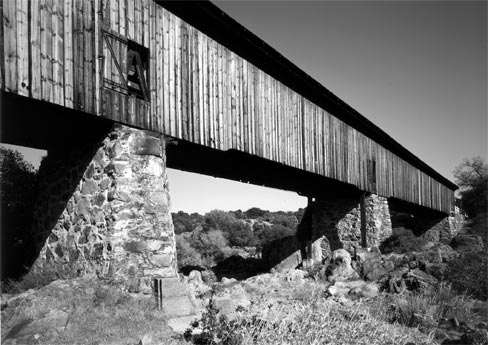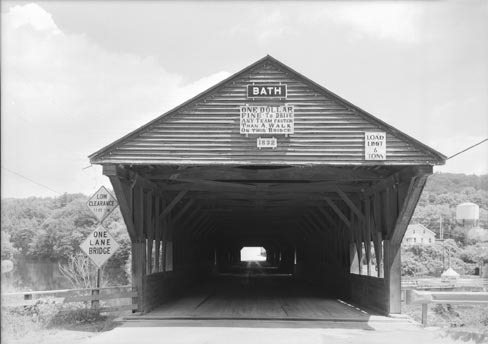Exhibit Review
Covered Bridges: Spanning the American Landscape
Historic American Engineering Record, the Smithsonian Institution, and the Federal Highway Administration; Exhibit design and fabrication: SITES; Curator: Lola Bennett
Traveling exhibit
As visitors pass through the replica covered bridge portal to the Covered Bridges: Spanning the American Landscape exhibit, they are quickly transported to another era when the covered bridge was just another feature of a developing landscape. Back then, covered bridges received no special attention: They blended into the countryside and were viewed as a necessity for commerce and travel. Today, the American covered bridge has become a cultural icon for many reasons, be it nostalgia or its formal and photogenic qualities. Covered bridges were not an American invention. They had European origins, with the first known wooden bridges built across the Rhine River during the time of the Roman emperor Julius Caesar in 55 B.C. However, American ingenuity, inventiveness, and craftsmanship carried the covered bridge to new engineering heights with the development of a number of innovative truss styles.
The Covered Bridges exhibit aptly tells the story of America's covered bridges through a series of three-sided kiosks featuring historic photographs, diagrams, models, drawings, artifacts, and descriptive text. The exhibit traces the development of the covered bridge from the Schuylkill Permanent Bridge, built by Timothy Palmer in Philadelphia in 1805, to the many pioneer bridge builders who had gained national recognition for their patented truss styles. Interspersed with historic photographs and quotes attributed to these legendary bridge builders, the exhibit illustrates the various truss designs with photographs and diagrams and points out the distinct advantages of each style of truss. During the heyday of covered bridge building in the mid to late 19th century, it is estimated that over 10,000 covered bridges dotted the American landscape, of which only about 750 remain. Maps show the progression of covered bridge building as the nation expanded westward, as well as the locations of those that survive today.
Another set of panels explains the undercover workings of the bridges and discusses in layman's terms how the wooden components are held together either by tension or compression. The exhibit also covers the tools used to make these functional wooden masterpieces. Few people today realize that wooden truss bridges were erected without electric tools or diesel powered machinery.
"Birth of a Cultural Icon" is the title of another series of panels illustrating how the covered bridge came to be recognized as a stalwart symbol of American society and was used extensively in art and advertising to portray sturdy, steadfast, and enduring qualities associated with consumer products. Advertising painted on the sides or entrances of covered bridges promoted a wide range of products and services, from a traveling salesman's homespun cures to the circus coming to town to a refreshing Coca Cola, "Sold Everywhere" for 5 cents!
 |
The Knights Ferry Bridge in Stanislaus County, California, shown here in this 2004 photograph, dates from 1864. (Photograph by Jet Lowe, courtesy of the National Park Service.) |
Covered bridges were taken for granted and often neglected or left for ruin. In the 1920s, these bridges began to attract the attention of budding preservation groups that recognized their historical significance, tourism appeal, the beauty they imparted to their surroundings, as well as their continued functional importance as transportation components. "Saving America's Covered Bridges" acknowledges the individuals and groups who have led the effort to preserve our remaining covered bridges and outlines current programs to record, maintain, and restore covered bridges where possible.
The exhibit is very appealing both visually and in its content. The visitor, whether casually interested in covered bridges or a seasoned covered bridge enthusiast, will walk away with a greater appreciation of these venerable transportation landmarks from our past.
Although this traveling exhibit tells the broad story of America's covered bridges very well, no exhibit can completely capture the entire essence of the subject, especially the local or regional elements and the folklore that accompany specific local covered bridges. The organizations and institutions hosting the exhibit have the opportunity to supplement the national exhibit with material showcasing local covered bridges either through photographic displays of long-gone covered bridges or lectures or seminars by renowned covered bridge experts or researchers. Tours of local covered bridges might even be arranged for the more adventuresome who want to see first hand how these time-honored landmarks from our past have become icons.
Covered Bridges: Spanning the American Landscape was developed by the Historic American Engineering Record, a program of the National Park Service, and the Smithsonian Institution Traveling Exhibition Service, and is funded in part by the Federal Highway Administration. Also contributing were the National Society for the Preservation of Covered Bridges, Inc., Arnold M. Graton and Associates, a number of covered bridge societies, and Joseph D. Conwill, Richard Sanders Allen, Sarah Laaff, and other individuals. The exhibit made its debut at the State Museum of Pennsylvania in Harrisburg in March 2006 and is continuing its national multi-city tour through 2009. A tour itinerary, promotional materials, sample images, and other information on covered bridges and the exhibit are available online at http://www.sites.si.edu/exhibitions/exhibits/bridges/main.htm.(1)
Thomas E. Walczak
Theodore Burr Covered Bridge Society of Pennsylvania
Note
1. See also Joe Flanagan, "Spanning America: The Historic American Engineering Record Documents a Legacy of Covered Bridges," Common Ground: Preserving Our Nation's Heritage (Winter 2004): 26-37.

